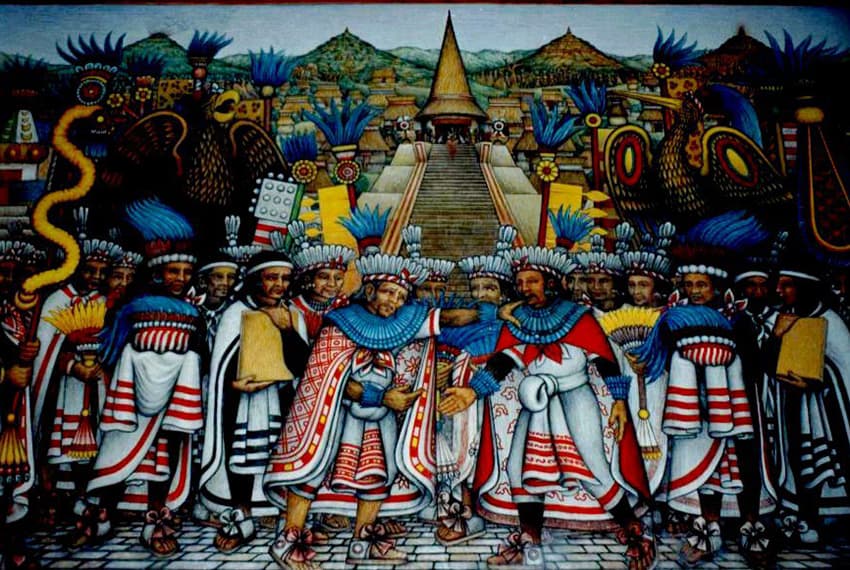Five hundred years ago, Hernán Cortés was marching from Tlaxcala on his way to the final defeat of the Aztec capital, Tenochtitlan. Because the role of Tlaxcala in the story of the Conquest is absolutely pivotal, the state has an awkward place in the culture of modern Mexico.
Today, Tlaxcala is Mexico’s smallest state, living in the shadows of its much larger neighbors, Mexico City and Puebla. From the pre-Hispanic to the modern period, it has a long history of fighting to remain a distinct entity.
This struggle is behind its role in the Conquest. Cortés did not achieve this feat with a few hundred soldiers, some horses and firearms. He sized up the political situation in Mesoamerica and took advantage of the Aztecs’ Achilles heel: how much they were hated by their neighbors.
He started by allying himself with the peoples on the Veracruz coast. After learning of Tlaxcala’s long struggle to remain independent of the sprawling Aztec Empire, he went there with his new expanded forces.
Despite its proximity, Tlaxcala had not been taken over by the Aztecs, at the price of constant warfare and a trade embargo that crippled the economy. Simply put, the Tlaxcalans had more than enough reason to want the Aztec Empire wiped out.

That did not mean they ran to join Cortés. When the Spanish reached the Tlaxcala border, they sent emissaries to ask permission to enter and meet with the Tlaxcalan lords. They received no answer.
Cortés entered anyway, sparking a series of battles that demonstrated the power that the Spanish had and convinced the Tlaxcalans to negotiate.
It was not an easy position for them to be in. On the one hand, you have a rival empire that is wearing you down, and on the other, you are confronted by a people you know nothing about and who has technology way beyond yours. It may simply have been a question of “Which was the lesser evil?”
For Cortés, an alliance with the Tlaxcalans was crucial. It would give him a base from which to attack the heart of the Aztec Empire. Tlaxcala not only knew the enemy well but was still a formidable power in its own right.
A treaty was worked out. At its most basic, it allowed Tlaxcala to maintain a separate identity in the coming colonial order, but they did have to pledge allegiance to the Spanish king and accept Catholicism.
They were also promised privileges that other indigenous peoples would not have, including keeping their names. This is why if you come across a Mexican with a Náhuatl family name (e.g. Desiderio H. Xochitziotzin), they have Tlaxcalan heritage.

After securing the alliance, Cortés set out for Tenochtitlán to meet Moctezuma. That round ended with the Night of Sorrows (La Noche Triste). Cortés and his men were routed from the city by its residents, who also murdered their emperor.
What was left of the Spanish and their allies limped back to Tlaxcala in the summer of 1520. Cortés did not really know what the reception would be. Not all of the Tlaxcalan leaders were amenable to the alliance with the Spanish, and now Cortés showed that he was not invincible.
In addition, the new Aztec emperor, Cuitláhuac, opened diplomatic channels, offering to end the trade embargo if the Tlaxcalans would sever their ties to the Spanish and join them. It was debated by the Tlaxcalan leadership. Had they accepted, it would have been the end of Cortés.
But they remained with the Spanish, mostly likely due to their burning hatred of the Aztecs. They probably didn’t trust the Aztecs to keep their word either.
After licking his wounds and reaffirming his alliance with Tlaxcala, Cortés was able to leave again for Tenochtitlán on December 28, 1520, accompanied by Tlaxcalan warriors. Tenochitlán fell on August 13, 1521.
Tlaxcala’s strategic importance bought it pledges from Cortés. However, the Spanish were not all that good at keeping their promises either.

The Tlaxcalans had to fight to get colonial authorities to recognize their rights on various occasions, including direct appeals to the Spanish Crown. One of these appeals resulted in the Tlaxcala Codex, which documents the alliance from the Tlaxcalans’ perspective.
Before the 20th century, it was these privileges, along with roles that Tlaxcalans played in expanding New Spain both northward and southward that caused much of the resentment against them.
The idea of the Tlaxcalans as traitors came with modern ideas of indigenous identity, basically placing the state and its residents in the same category of La Malinche, Cortés’ indigenous interpreter.
But the truth is that there was no “pan-indigenous” identity before the arrival of the Europeans, no more than there was a pan-European identity. Like everywhere else, Mesoamerican peoples had conflicts among themselves that defined their world.
Over the centuries, Tlaxcala lost its privileges and even almost disappeared. After independence, it was once integrated with Puebla and once with the province of Mexico (which included México state and Mexico City).
But efforts to regain separate status were successful, and it is now one of the sovereign states of the Mexican Republic — politically secure, but not so much culturally.

There are jokes and internet memes stating that the state does not really exist because it is easy to overlook geographically and with such major cities nearby. Like Puebla, Toluca, Querétaro and Cuernavaca, it is close enough to the capital to be part of the growing megalopolis, but rapid growth has come here only recently.
Though not as strong as in the recent past, the moniker of “traitor” still creates a stigma that is difficult to live with, says University of Tlaxcala anthropologist Juan Carlos Ramos.
Leigh Thelmadatter arrived in Mexico 18 years ago and fell in love with the land and the culture in particular its handcrafts and art. She is the author of Mexican Cartonería: Paper, Paste and Fiesta (Schiffer 2019). Her culture column appears regularly on Mexico News Daily.
